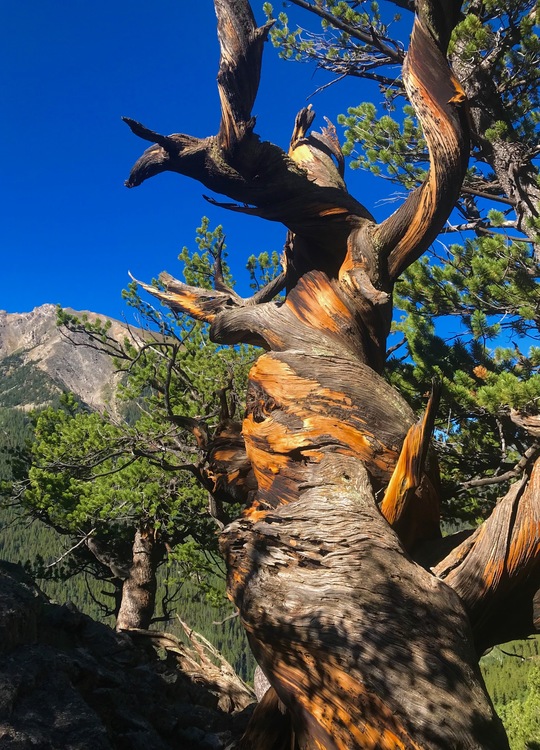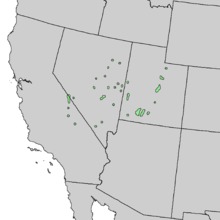Tree ID requested
|
|
This beauty and many others are on top of Monitor Rock. What species is the tree and does anyone really know why the trunk and branches are twisted? They are beautiful trees living in a harsh environment and every one exhibits the same characteristics. Thanks for any info. Lynn |
|
|
Seems like a Bristlecone pine? Krummholz effect. |
|
|
I agree. Looks like Bristlecone pine. Some of them can be close to 2000 yrs old! Strong prevailing winds on the ridge tops I think is the cause of their twisted stunted appearance. I believe they are protected. |
|
|
https://www.youtube.com/watch?v=YCEaYInJbos |
|
|
The needles of pines help with identification. From the NPS: "A bristlecone's needles are about one inch long, and grow in packets of five." |
|
|
Another strong contender: Limber Pine, Pinus flexilis. |
|
|
I agree about limber pine being a possibility, too. Limber pine also has fascicles of 5 needles, but the needles don't typically point out at as much of a right angle from the twig as those of bristlecone pine. Bristlecone pine needles also are typically found further up the twig, which combined with the right angles, gives bristlecone twigs a bottlebrush look. Of course, consistent with the name, cones would be definitive. These species often live in association, though the limber pine range goes further north. |
|
|
Not Hobo Greg wrote: Wrong, we have them here. https://www.5280.com/2017/07/colorado-by-nature-bristlecone-pines/ Having been born in CA and raised in CO, though, I say they both rock. |
|
|
Rocky Mountain bristlecone pine is found at elevation in Colorado (Pinus aristata), rather than Pinus longaeva, Great Basin bristlecone pine. |
|
|
There are two species of bristlecone pine. Not Hobo Greg's map shows the distribution of the Great Basin bristlecone pine (Pinus longaeva). Colorado has Rocky Mountain bristlecone pines (Pinus aristata). Both are extraordinarily long-lived. The oldest living P. aristata (located near South Park) germinated in 422 BC. The oldest P. longaeva (in the White Mountains of California) is more than 2,600 years older than that. |
|
|
Another ID clue is the bristlecone has dots of white resin on its needles. Dead giveaway for the species. |
|
|
Lots of still-living limber pines on Monitor... I bet it used to be one of those. |
|
|
While I’m not going to join in on the debate of species (bristlecone?) I thought I’d share some terminology. Geoff was correct in his thoughts regarding the wind causing the twisting. The are called krummholz trees when this occurs. It’s a German word referring trees in alpine terrain who’s growth has been stunted and have been twisted and turned by the wind. Often a survival technique in a sense allowing the trees to stay lower than they normal would where growing taller would surely result in death. They are the natural bonsai trees of gnarture with the wind as their master instead of the human hand. |
|
|
I haven’t found Bristlecone that far north in the Sawatch, only Limber Pine. I believe the cones are also a bit different. The latitude, and elevation make me think that is most likely Limber Pine. Definitely a beautiful tree! |
|
|
Lynn, It's Brett from the Y! You've raised a question that is absolutely in my wheelhouse :-) I am 99.9% certain that the trees near the crag are mostly Pinus flexilis; ie. Limber pine. At the elevation and latitude of Monitor Rock and with five-needles per fascicle, it's a Limber pine. Krummholz describes the condition of alpine and subalpine trees that are heavily exposed to the elements. So, in this way, it is a Krummholz. |
|
|
Fun fact: Limber pine is found at both tree lines, i.e. subalpine (as in the OP's example), and plains (Vedauwoo and Pawnee Buttes, for example). |

 Continue with onX Maps
Continue with onX Maps Sign in with Facebook
Sign in with Facebook






















